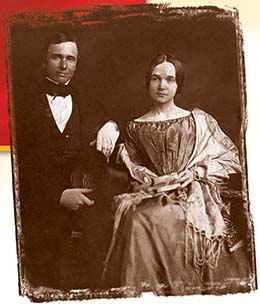SECTION 1: Rival Plans for Reconstruction

Mary Chesnut and her husband, James ►
WITNESS HISTORY  AUDIO
AUDIO
Nothing Left But the Bare Land
Mary Chesnut was the wife of a wealthy and respected South Carolina planter and politician. During the Civil War, her husband resigned from the United States Senate to fight for the Confederacy. Now, at war’s end, the family was penniless. The world they had known was gone. Mary Chesnut described the devastation.
“Mrs. Bartow drove me to our house at Mulberry. On one side of the house, every window was broken, every bell torn down, every piece of furniture destroyed, every door smashed in…. [The Yankee soldiers] carried off sacks of our books and our papers, our letters were strewed along the Charleston road. Potter’s raid ruined us. He burned our mills and gins, and a hundred bales of cotton. Indeed nothing is left now but the bare land.”
—Mary Boykin Chesnut, May 1865
Objectives
- Explain why a plan was needed for Reconstruction of the South.
- Compare the Reconstruction plans of Lincoln, Johnson, and Congress.
- Discuss Johnson’s political difficulties and impeachment.
Terms and People
- Reconstruction
- Radical Republican
- Wade-Davis Bill
- Freedmen’s Bureau
- Andrew Johnson
- black code
- Civil Rights Act of 1866
- Fourteenth Amendment
- impeach
- Fifteenth Amendment
NoteTaking
Reading Skill: Identify Main Ideas Use a chart to record main ideas about Reconstruction.

Why It Matters Even before the end of the Civil War, Congress and the President disagreed over how the seceded states would rejoin the Union. When the war ended, bitterness between the North and South was compounded by a power struggle between the executive and legislative branches of government. The issues that arose and how they were dealt with would have consequences for generations to come. Section Focus Question: How did the Radical Republicans’ plans for Reconstruction differ from Lincoln’s and Johnson’s?
The Issues of Reconstruction
When the Civil War ended, parts of the South lay in ruins—homes burned, businesses closed, many properties abandoned. African Americans, though emancipated, lacked full citizenship and the means to make a living. During the era of Reconstruction (1865–1877), the federal government struggled with how to return the eleven southern states to the Union, rebuild the South’s ruined economy, and promote the rights of former slaves.
How Will Southern States Rejoin the Union?
To many Americans, the most important issue was deciding the political fate of Confederate states. Should Confederate leaders be tried for treason, or should they be pardoned so that national healing could proceed as quickly as possible? And what should be the process by which southern representatives could reclaim their seats in Congress?




